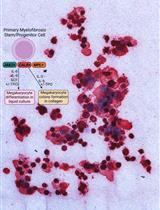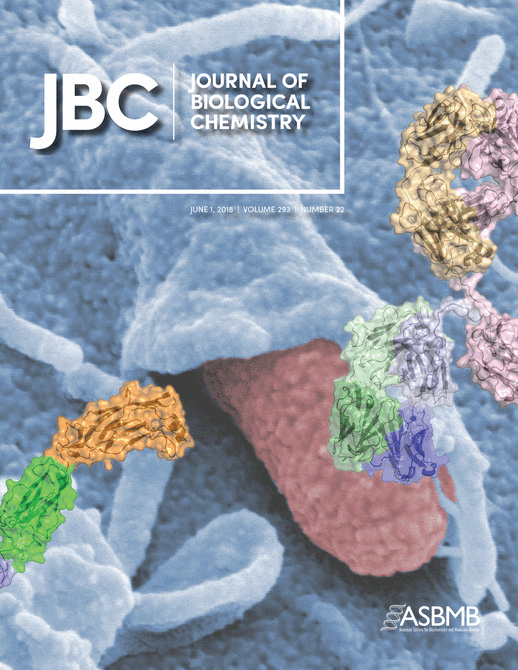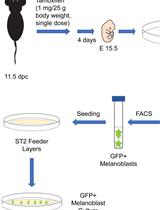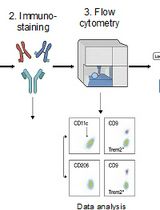- EN - English
- CN - 中文
Preparation of Single Epithelial Cells Suspension from Mouse Mammary Glands
小鼠乳腺单个上皮细胞悬液制备
发布: 2020年02月20日第10卷第4期 DOI: 10.21769/BioProtoc.3530 浏览次数: 5945
评审: Pooja VermaPia GiovannelliPilar VillacampaAnonymous reviewer(s)

相关实验方案

来自骨髓增生性肿瘤患者的造血祖细胞的血小板生成素不依赖性巨核细胞分化
Chloe A. L. Thompson-Peach [...] Daniel Thomas
2023年01月20日 2302 阅读
Abstract
Single cell RNA sequencing is a very powerful means for cellular heterogeneous studies and so becoming wildly utilized nowadays. To guarantee the success of such analysis, it is very important, though sometimes difficult, to obtain single cells suspension with high quality, especially from the primary solid organs like mammary glands. Digestion of mouse or human mammary glands with enzymes was previously described. However, the yield, viability, especially the separation degree of the cells have rarely been noticed in these studies. Here we described a detailed protocol for the single epithelial cells suspension preparation from mouse mammary glands, which could be applied for single cell RNA sequencing on different platforms. This protocol could be well adapted for dissociation of other solid organs and tumors, and the single cell suspension could be also used for many other experiments.
Keywords: Single cells (单细胞)Background
The mammary gland is very heterogeneous, including many distinct types of cells, such as epithelia, endothelia, adipocytes, fibroblasts and immune cells. The abnormality of epithelia is the main cause for many mammary diseases, like mammary tumors (Prat and Perou, 2009). So, it is of great significance to study the cellular heterogeneity of mammary epithelia in normal and disease conditions. And the single cell RNA sequencing is one of the methods used to study the cellular heterogeneity. The mammary epithelium is mainly composed of two distinct lineages, the basal and luminal cells (Shackleton et al., 2006). According to previous studies, these two cells populations could be well distinguished through flow cytometry analysis for the mouse mammary cells by using cell surface markers CD24 and CD29 (or CD24 and CD49f), as the basal and luminal cells are characterized with CD24MidCD29Hi cells and CD24HiCD29Lo, respectively (Shackleton et al., 2006). Still little attention was paid on the cell numbers, viability and the separation degree of the cells in the flow cytometry analysis and cell sorting. But the cell quality is very important for the single cell RNAseq experiments. To meet this end, we devised a protocol with the combination of the red blood cells’ removal, epithelial cells’ enrichment, and futher cell sorting to separate basal and luminal cells with high cell viability. It’s a better approach to prepare single cells suspension for single cell RNA sequencing. Besides, the protocol has been verified for its adaption towards other solid organs, like liver and brain, as well as tumor/cancer tissues from breast, liver, colon and other organs of mouse and human.
Materials and Reagents
- 50 ml centrifuge tubes (Corning, catalog number: CLS430829)
- 1.5 ml micro-tubes (Axygen, catalog number: MCT150-C-S)
- Pipette tips 10 µl, 200 µl and 1,000 µl (Axygen, catalog numbers: T-400, T-200-Y and T-1000-B)
- Sterile serological pipettes (5 and 10 ml) (Corning, catalog numbers: CLS4487 and CLS4488)
- FACS tubes (FALCON, catalog number: 352058)
- 40 μm cell strainer (FALCON, catalog number: 352340)
- Cell counting chambers (Nexcelom Bioscience, catalog number: CHT4-SD100)
- 0.2 μm Nalgene syringe filter (Thermo Fisher Scientific, catalog number: 725-2520)
- 50 ml syringe (TERUMO, catalog number: SS-50LE)
- Female FVB mice for mammary gland isolation (provided by Animal facility core, Faculty of Health Sciences, University of Macau)
- DMEM/F12 medium (Thermo Fisher Scientific, catalog number: 11330032)
- Fetal Bovine Serum (FBS) (Thermo Fisher Scientific, catalog number: 26140079)
- HBSS (Thermo Fisher Scientific, catalog number: 14140112)
- Hydrocortisone (Sigma-Aldrich, catalog number: H0888)
- Insulin (Sigma-Aldrich, catalog number: 91077C)
- EGF (Thermo Fisher Scientific, catalog number: PHG0313)
- Cholera toxin (Sigma-Aldrich, catalog number: C8052)
- Collagenase Type 3 (Worthington Biochemical Corporation, catalog number: LS004183)
- Hyaluronidase (Sigma-Aldrich, catalog number: H3506)
- Dispase II (Roche, catalog number: 04942078001)
- Deoxyribonuclease I (Worthington Biochemical Corporation, catalog number: LS002145)
- HEPES (1 M) (Thermo Fisher Scientific, catalog number: 15630080)
- DPBS (Thermo Fisher Scientific, catalog number: 14190250)
- 0.25% Trypsin-EDTA (Thermo Fisher Scientific, catalog number: 25200056)
- 1x RBC lysis buffer (Thermo Fisher Scientific, catalog number: 00-4333-57)
- Trypan blue dye (STEMCELL Technologies, catalog number: 07050)
- EasySeq Mouse Epithelial Cell Enrichment kit (STEMCELL Technologies, catalog number: 19868)
- Anti-mouse CD24-PE-Cy7 antibody (BD Biosciences, catalog number:560536)
- Anti-mouse CD29-APC antibody (Biolegend, catalog number:102216)
- DAPI solution (1 mg/ml) (Thermo Fisher Scientific, catalog number: 62248)
- Albumin, Bovine (BSA) (VWR LIFE SCIENCE, catalog number: VWRV0332)
- Digestion buffer A (see Recipes)
- Digestion buffer B (see Recipes)
- FACS buffer (see Recipes)
Equipment
- Sterile scissors and forceps
- Pipette
- Pipette-Aid
- Biosafety cabinet for cell culture work
- Holder for centrifuge tubes
- Humidified cell culture incubator set to 37 °C, 5% CO2
- Orbital shaker (Allsheng, OS-100) settled in cell culture incubator
- Centrifuge with adaptors for 50 ml centrifuge tubes and FACS tubes, for use at room temperature
- EasySep Magnet (STEMCELL Technologies, catalog number: 18000)
- Cell counter (Nexcelom Bioscience, Cellometer Auto 2000)
- BD FACSAria III for cell sorting
Software
- BD FACSDiva 6.1 for BD FACSAria III
Procedure
文章信息
版权信息
© 2020 The Authors; exclusive licensee Bio-protocol LLC.
如何引用
Readers should cite both the Bio-protocol article and the original research article where this protocol was used:
- Sun, H., Xu, X. and Deng, C. (2020). Preparation of Single Epithelial Cells Suspension from Mouse Mammary Glands. Bio-protocol 10(4): e3530. DOI: 10.21769/BioProtoc.3530.
- Sun, H., Miao, Z., Zhang, X., Chan, U. I., Su, S. M., Guo, S., Wong, C. K. H., Xu, X. and Deng, C. X. (2018). Single-cell RNA-Seq reveals cell heterogeneity and hierarchy within mouse mammary epithelia. J Biol Chem 293(22): 8315-8329.
分类
细胞生物学 > 基于细胞的分析方法 > 流式细胞术
细胞生物学 > 细胞分离和培养 > 细胞分离 > 流式细胞术
细胞生物学 > 组织分析 > 组织分离
您对这篇实验方法有问题吗?
在此处发布您的问题,我们将邀请本文作者来回答。同时,我们会将您的问题发布到Bio-protocol Exchange,以便寻求社区成员的帮助。
Share
Bluesky
X
Copy link











